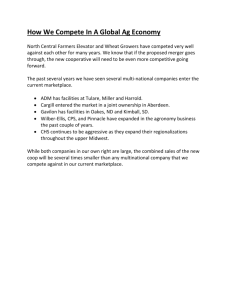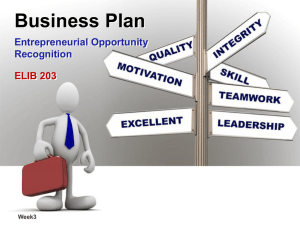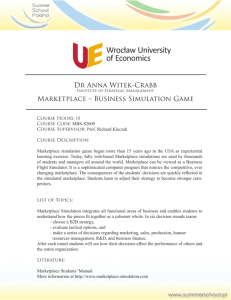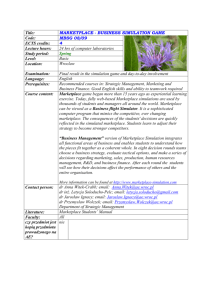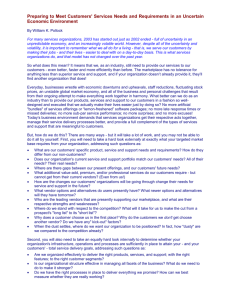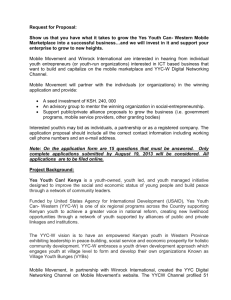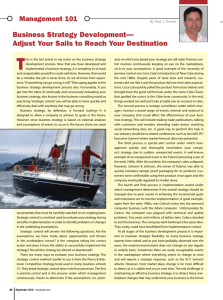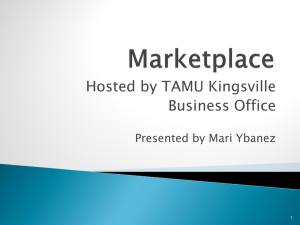Opportunity
advertisement
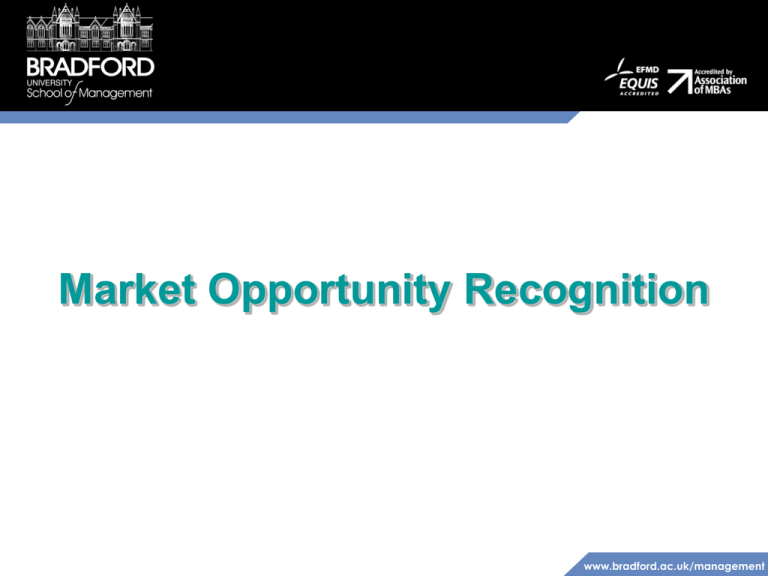
Market Opportunity Recognition www.bradford.ac.uk/management Definitions Creativity Characterized by originality and expressiveness; imaginative Imagination The formation of a mental image of something that is neither perceived as real nor present to the senses. Idea Something, such as a thought or conception, that potentially or actually exists in the mind as a product of mental activity. Opportunity A favourable or advantageous circumstance or combination of circumstances. Imagination is more important than knowledge… Albert Einstein (1879-1955) Creative v Logical Thinking Creative Seeks questions Diverges Explores different views Restructures Logical Seeks answers Converges Asserts best or right view Using existing structure Seeks ways an idea might help Says when an idea will not work Welcomes discontinuous leaps Uses logical steps Welcomes chance intrusions Open ended Focuses on what is relevant Closed Innovation Is the process by which entrepreneurs convert opportunities into marketable ideas. It is the means by which they become catalysts for change. •New Product •New method of doing the same product •New Source of Raw materials •New Market •New way of organising your business “The single biggest cause of failure is not lack of money but that you haven’t come up with something that the world wants.” Larry C.Farrell Conception + Invention + Exploitation Drucker’s Sources of Innovative Opportunity • The unexpected. Success IBM. Failure Jacket Potatoes • The incongruity. Possible v Actual. Overnight Delivery. • Process needs. Sugar free products. Caffeine free. • Changes in industry/market structure. Digital Cameras PLUS • Demographic changes. Age profile • Changes in perception, mood or meaning. Fashion • New knowledge. Mobile phones. Types of Innovation • INVENTION - totally new, product or service [Airplane, Light bulb, Telephone] • EXTENSION – New use or different application of existing product or service [McDonalds, Holiday Inn] • DUPLICATION – Creative replication of an existing concept [Pizza Hut, Virgin] • SYNTHESIS – Combining into a new formulation [Internet Cafes] HBDI Herrmann Brain Dominance Instrument What is an Opportunity? • Opportunity Defined – An opportunity is a favorable set of circumstances that creates the need for a new product, service, or business idea. – Most entrepreneurial firms are started in one of two ways: • Some firms are internally stimulated. An entrepreneur decides to start a firm, searches for and recognizes an opportunity, then starts a business. • Other firms are externally stimulated. An entrepreneur recognizes a problem or an opportunity gap and creates a business to fill it. What is an Opportunity? An opportunity has four essential qualities Window of Opportunity & Life Cycle $100M $50M $25M $3M $1M Start up High Growth Maturity Time (years) Stability Three Classic Life Cycles 500 In $Millions High potential firm 100 Foundation firm 25 5 1 Lifestyle firm 1 2 3 4 5 6 7 Years 8 9 10 Three Ways to Identify An Opportunity Observing Trends First Approach: Observing Trends Environmental Trends Suggesting Business or Product Opportunity Gaps Environmental Scanning Scanning: Detect Changes Monitoring: Track Events Affecting Business Forecasting: Making Plausible Projections Assessing: ‘What does it all mean?’ Trend Analysis • Trends identify emerging needs.. • SEEDTIP analysis – – – – – – – Societal/sociological trends Economic trends Environmental/Ecological trends Demographic trends Technological trends International trends Political/Legal trends [Café society] [Life coaches] [Ecotourism] [In home care] [VOIP] [China/India emerging] [Health & Safety] • When two or more trends come together… http://www.trendhunter.com/trends/interactive-wallpaper-sl2010-allyearlong-calendar http://www.springwise.com/ Exploit trends • 24 hour society • ‘Money rich, time poor’ • Demographic change: age, urban living, growth patterns • Environmental issues • Globalisation • Legislation • Desire for ‘gadgets’ • Communication Solving a Problem Second Approach: Solving a Problem Sometimes identifying opportunities simply involves noticing a problem and finding a way to solve it. These problems can be pinpointed through observing trends and through more simple means, such as intuition, serendipity, or chance. Some business ideas are clearly initiated to solve a problem. For example, Symantec Corp. created Norton antivirus software to guard computers against viruses. Solving a Problem Businesses Created to Solve a Problem How entrepreneurs found ideas • Left xmas shopping too late, couldn’t find last minute gadgets GADGET SHOP • Market opportunity to sell mobile phones direct CAR PHONE WAREHOUSE • Wife crying because of seven days wait for new glasses VISION EXPRESS • Passion for making scents and lotions turned into JO MALONE Create Curiosity – Open Mind & Observation of Circumstances Finding Gaps in the Marketplace Third Approach: Finding Gaps in the Marketplace • Gaps in the Marketplace – A third approach to identifying opportunities is to find a gap in the marketplace. – A gap in the marketplace is often created when a product or service is needed by a specific group of people but doesn’t represent a large enough market to be of interest to mainstream retailers or manufacturers. • This is the reason that small clothing boutiques and specialty shops exist. • The small boutiques, which often sell designer clothes or clothing for hard-to-fit people, are willing to carry merchandise that doesn’t sell in large enough quantities for Wal-Mart, GAP, or JC Penney to carry. Personal Characteristics of the Entrepreneur Characteristics that tend to make some people better at recognizing opportunities than others Prior Experience Social Networks Cognitive Factors Creativity Social Capital - Per Lovgren Management Consultants Foundry Consultants Network of Professors of Engineering Network of Management Consultants Birley & Muzyka (2000:45) Who Do You Know? Tutors Advisors Work Colleagues Professional Contacts Family YOU Friends Other Students Staff Sources Of Ideas – Insights - experience in profession or industry 43% – – – – – 15% 11% 7% 5% 3% Challenge - could do better Unfilled/overlooked niche in marketplace Systematic search for business opportunities Brainstorm - cannot explain it Hobby or vocational interest Source: Entrepreneurship, John G Burch Unlocking Value Ideas Personality Motivation & Drivers Ability to Learn Capabilities Unlocking Personal Value Opportunities Know How & Expertise Relationships & Contacts Ventures Rae (1999) What Kind of Business Should I Start? • • • • • • • • • • • Start with what you know. Do what you love. Don’t reinvent the wheel, just make it better Focus on a niche Consider the franchising option Know what sets you apart from the competition Imitate an existing product Buy an existing business Become and agent or distributor Sell your services as a consultant More…? • Above all take your time Source: entrepreneur.com
